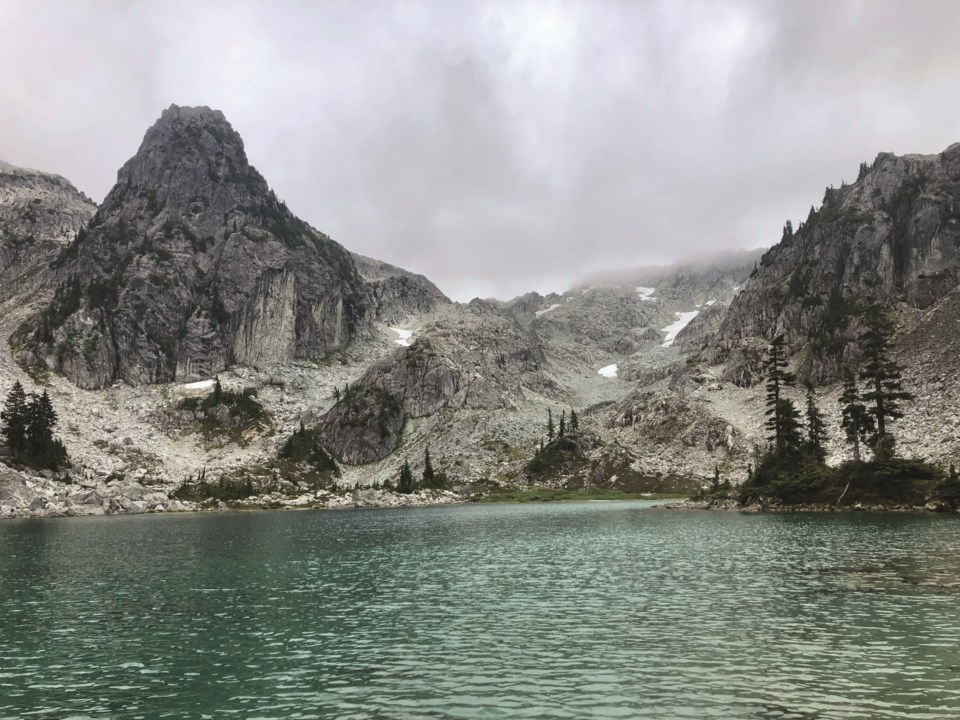If you’re planning an overnight trip to Watersprite Lake in 2022, the experience might look a little different than your previous visits.
The B.C. Mountaineering Club (BCMC) has entered into an partnership agreement with Recreation Sites and Trails BC—a division of the province’s Ministry of Forests, Lands, Natural Resource Operations and Rural Development (FLNRO)—to manage the popular hiking trail and alpine lake in Squamish after the area was designated a formal recreation site earlier this year.
“I’ve been told this is a bit of an experiment in that this will be the first alpine recreational site in the province,” said David Scanlon, a member of BCMC’s executive board and a past president of the club.
Scanlon helped spearhead the construction of Watersprite’s trail and existing hut more than a decade ago. The 10-person, reservation-only BCMC hut at Watersprite Lake opened to the public in 2017, after the access trail was completed in 2016. The recreation site will be bordered on two sides by Garibaldi Provincial Park.
Beginning next summer, Scanlon said the plans are to have 20 newly built, pay-for-use lakeside campsites available by reservation only. At this point, the fees will be set at $15 per campsite, per night, he said.
Because there wasn’t space near the cabin to comfortably pitch tents, Scanlon said most backpackers naturally began heading to a flat section of terrain on the far side of the lake. BCMC volunteers put in “a tremendous amount of work to put a trail through that rockslide to the far end of the lake, and it worked out really well,” he explained.
Turning Watersprite into a formal rec site “is going to be quite the transition, because everybody’s been under the impression that you just go up and grab a spot. This is going to be new,” said Scanlon. “This will be a challenge and I’m anticipating a few hiccups, but we’ll see.”
Under the agreement, BCMC volunteers will continue to operate and maintain the site, from taking point on ecological restoration, research and conservation projects to completing trail and facility work and handling public outreach. In addition to the volunteer BCMC custodians, a recreation officer will also attend the site on occasion.
B.C. recreation officer Alistair McCrone said while stakeholders are currently working on a booking and funding structure for the Watersprite site, work is also underway on a strategy to improve interactions between the area’s threatened mountain goat population and those recreating.
“What really changes when you establish a [recreation] site is now the province can act and take responsibility and fund [initiatives] within that site to manage recreation, and we can make real changes to manage recreation,” he explained. “And we can partner with other stakeholder groups that are concerned or want to contribute like the BCMC, and more effectively, we can manage the recreation together there.”
Added McCrone, “We are working on a lot of different ways to refine and improve the experience for the public there, and also manage the impacts of a high level of use on a fairly fragile environment.”
Including initiatives like trail work, toilets, tent pads, bear caches and other infrastructure, McCrone estimated that FLNRO and the BCMC combined have put in nearly $100,000 worth of work over the last four years, “getting the site to a point where it can stand a high level of use.”
The area has experienced a massive traffic spike in recent years: Watersprite logged a 126-per-cent increase in visitation from summer 2019 to summer 2020, though it saw traffic fall by 47 per cent from 2020 to 2021, according to data from FLNRO. Watersprite’s busiest day in 2020 occurred on Aug. 15, when 263 people visited the trail. Its busiest day this year was on Aug. 29, when 194 people ventured to the trailhead. In 2020, there were more than 4,000 people who visited the trail between June and November.
“We get about 5,000 people a year go up there, and we get about 1,000 to 1,200 people who use the cabin,” explained Scanlon.
He attributed the success of the site to the thousands of people who have hiked and camped in the area, whom he said have been “absolutely fantastic in keeping things neat and clean and tidy… and keeping it clean for the next person.”
McCrone, on the other hand, credited Scanlon and other BCMC volunteers for their endless hours of “hard work and consistency” to help the site keep up with that rapid development.
Though day-use passes have been one strategy that’s been increasingly used to help manage foot traffic in some of B.C.’s most popular provincial parks, that will not be the case for Watersprite, McCrone assured. “And if that was to change, there would be a long consultation process and public engagement before we ever did anything like that,” he said.
“When you talk about high levels of use, the most important thing to do is to design the infrastructure to handle it, to put the use where you want it, and provide the opportunity people want.”


